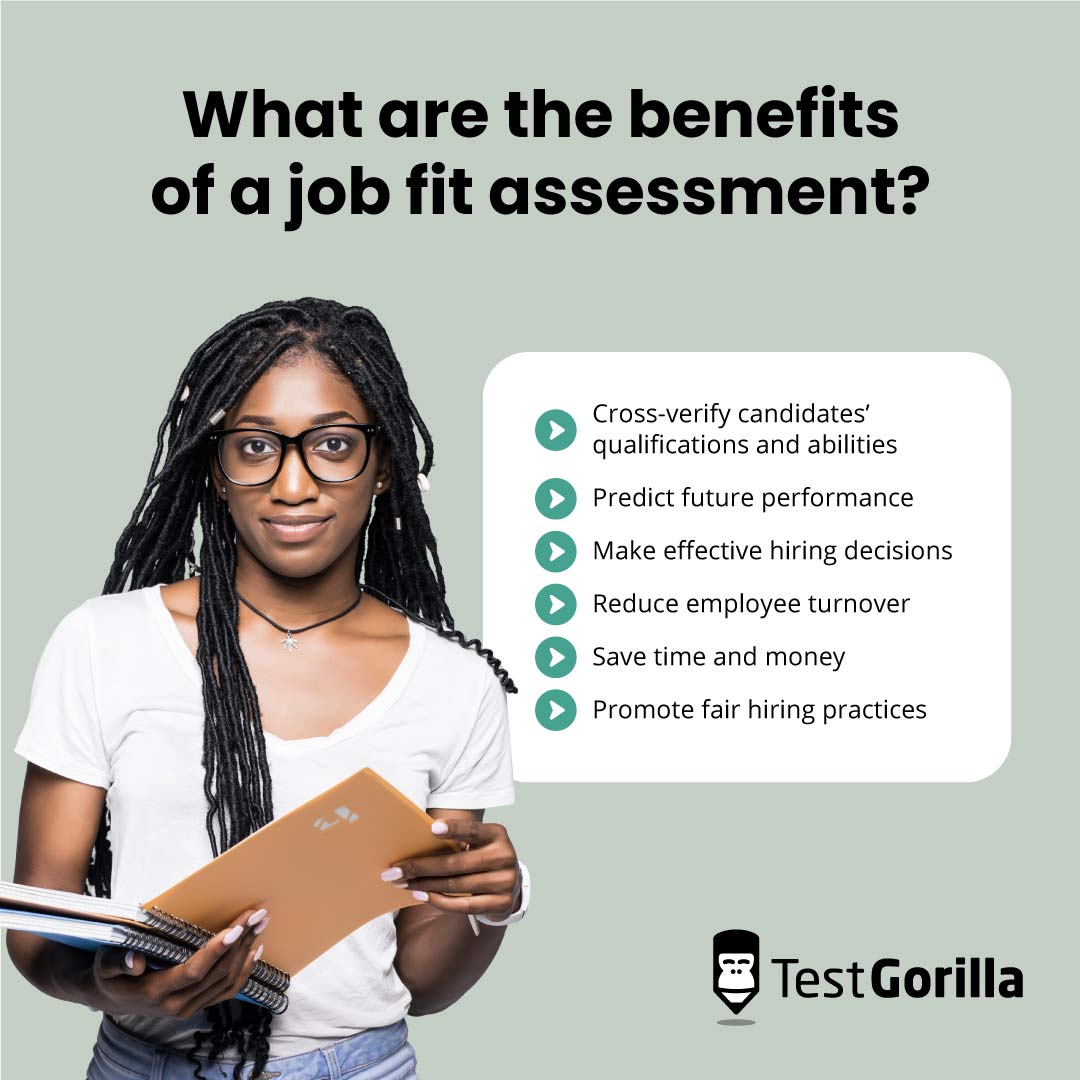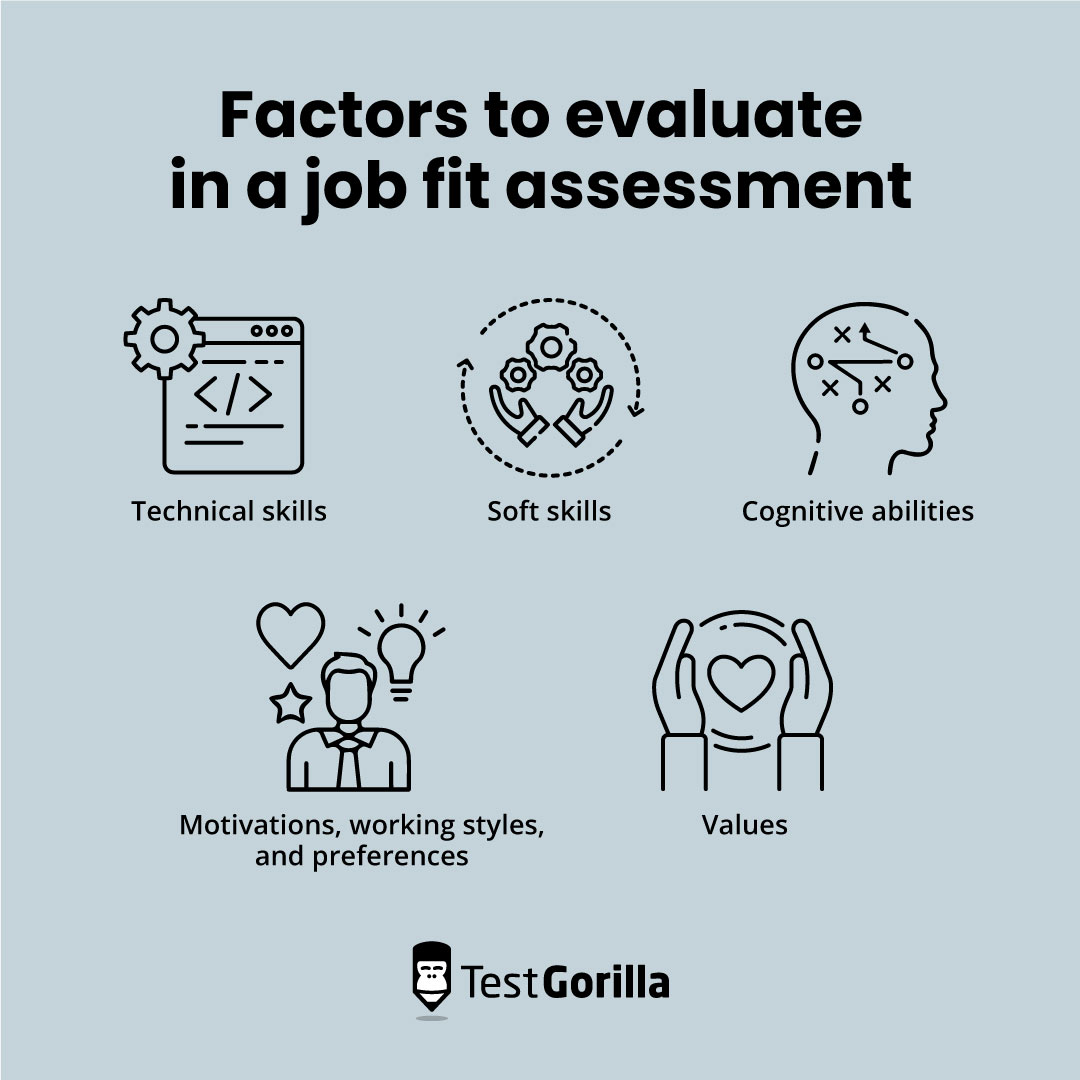Mis-hiring has damaging consequences for a company and puts the hiring team’s reputation at risk. An ill-fitting employee can result in lower productivity, more mistakes, team conflict, and many other problems. If you mis-hire an employee, you’ll eventually part ways with them and spend more time and money hiring, onboarding, and training the next person.
That’s why conducting a thorough job fit assessment before hiring candidates is so important. This method lets you test a candidate’s suitability for a role by examining their traits, motivations, skills, values, working styles, and more.
In this guide, we look at what a job fit assessment is and why it matters. We also discuss how to assess job fit so you can start making effective hiring decisions in your company.
What is a job fit assessment?
A job fit assessment is a process employers use to evaluate a candidate’s suitability for a specific role and company.
Commonly referred to as a job fit test or job fit analysis, this assessment examines candidates across various factors in relation to the job’s requirements, including:
Technical skills
Soft skills
Personality traits
Cognitive abilities
Motivations
Working styles and preferences
Values
You can assess candidates on these dimensions using online tests, questionnaires, and interviews.
A comprehensive job fit assessment aims to determine whether a candidate has what it takes to meet, or even exceed, the demands of a position. Furthermore, it shows you whether their working style, motivations, goals, and values are compatible with those of your company and its people.
What are the benefits of a job fit assessment?
Conducting a thorough job fit assessment has several robust benefits for a company. Some of its key advantages are listed below.
Cross-verify candidates’ qualifications and abilities
A candidate’s resume lists out their skills and professional experience. However, it doesn’t tell you about the level of skill or knowledge they possess, and resume screening offers no easy way to verify qualifications.
Job fit assessments use multiple testing methods to evaluate candidates’ qualities. Candidates are put through various assessments, including cognitive ability tests, technical and situational interviews, and questionnaires.
With these pre-screening assessments, you can dig deeper into candidates’ skills, abilities, and values and ask them for concrete examples of their experiences. Plus, you can cross-verify their performance using different testing methods to make sure they have the right qualities for the role.
For instance, you could evaluate a candidate’s suitability as a leader using their resume, a leadership behavioral interview, and a decision-making test to check their leadership qualities across all mediums.
Predict future performance
A job fit assessment is a holistic approach to hiring. Beyond simply measuring skills and expertise, it looks at candidates’ cognitive abilities, behavioral attributes, and values.
Testing these qualities can help you understand how candidates solve problems, make decisions, and think and act in different scenarios. For instance, a candidate who is charismatic, excels in negotiation, and demonstrates quick thinking and responsiveness is likely to thrive in sales and work effectively with difficult customers.
Make effective hiring decisions
In addition to verifying candidates’ skills and experience, you also need to check that their traits and motivations align with the company’s culture and workforce.
Without fully understanding your candidates, you could, for example, end up with a highly skilled developer who’s late to work every day or a knowledgeable marketer who finds the work boring. Scenarios like these typically result from ineffective hiring processes.
Job fit assessments test candidates on multiple dimensions, from traits and cognitive abilities to skills and motivations. When you assess job fit, you’ll have a complete understanding of candidates so you can make informed hiring decisions. This can prevent you and your new hires from facing unwanted surprises when they start the job.
Reduce employee turnover
Hiring the wrong person usually ends with you dismissing them or them leaving voluntarily. This increases employee turnover, which not only disrupts productivity but also puts your company’s reputation at risk.
One way a rigorous job fit assessment can prevent this is by looking at a candidate’s culture fit and working preferences before hiring them. For instance, if a candidate works better as an individual contributor, it’s best to avoid hiring them for a role that relies heavily on teamwork. Their inability to work well within a team will likely end in conflict and resentment, which could result in the candidate – or even the other team members – leaving.
By assessing job fit, you can find and address any red flags through the hiring process before making your final decision.
Save time and money
Using job fit assessments increases the likelihood of making an effective hire from the beginning. This means you don’t need to spend time and money rehiring and training a new person for the role if the mis-hire doesn’t work out.
Additionally, candidates who fare well in job fit tests demonstrate they have the skills and attributes to succeed in a role. They’re more likely to learn the position and start contributing towards company goals quickly, saving valuable time, and contributing effectively to company revenue.
Promote fair hiring practices
Job fit tests also provide you with an effective way to differentiate between candidates. For instance, if you must decide between two candidates with the same level of skills and expertise, you can base your decision on which candidate's traits and values align more with those of the company rather than subjective criteria.
Job fit assessments enable you to make objectively better hiring decisions and eliminate the bias inherent to the recruitment and selection process.
The best insights on HR and recruitment, delivered to your inbox.
Biweekly updates. No spam. Unsubscribe any time.
How to assess a candidate’s job fit
Following the steps below can help you understand how to assess job fit with your candidates.
Step 1: Define what a successful candidate looks like
To evaluate a candidate’s suitability for a role, you first need to establish what you’re looking for. For example, successful administrative assistants must excel at multitasking, possess strong organizational and communication skills, and exhibit quick and accurate typing abilities.
Defining exactly what you’re looking for can help you evaluate candidates against clear, objective criteria.
Step 2: Decide which qualities you want to assess
The next step is to determine which factors you want to test. A rigorous job fit assessment evaluates candidates on the factors below.
Technical skills
Take a close look at your applicants’ hard skills, areas of expertise, or specific certifications required to perform a job effectively. Examples include programming, coding, digital marketing, and data analysis.
Soft skills
Test your applicants’ interpersonal skills and abilities to determine if they can work effectively in a professional environment. For example, you can test their communication and presentation skills.
Personality traits and attributes
Understand whether your candidates possess the competencies and behavioral attributes required to succeed in a role and mesh well with your company’s culture and people. For instance, you could ensure that your leadership candidates demonstrate resilience, charisma, and empathy.
Cognitive abilities
Examine your applicants’ thought processes and thinking skills, including critical thinking, problem-solving, and decision-making skills. Confirm that their cognitive abilities will enable them to excel in the role you need to fill.
Motivations, working styles, and preferences
Understand a candidate’s ambitions, working styles, and preferences to ensure these factors align with role requirements. For example, consulting companies often look for candidates who are comfortable with regular work-related travel.
Values
Finally, ensure that a candidate’s values align with the company’s core values. For example, nonprofits likely want to hire an employee whose values relate to their company’s mission so the employee can stay engaged and committed to their role.
Step 3: Use suitable testing methods to assess job fit
The best job fit assessments use a combination of testing methods to look at candidates’ fit and compatibility for a role. Here are some of the most commonly used testing methods.
Resume screening
Candidate resumes can give you some insight into their work and educational background, years of experience, and skills. However, resumes shouldn’t be the only tool you rely on to assess job fit.
Online testing
Pre-employment testing is the most effective part of any job fit assessment. It lets you test candidates on multiple qualities and gives you reliable and objective results to drive your hiring decisions.
With TestGorilla, you can roll out, track, and analyze your online tests from a single platform. TestGorilla’s extensive test library enables you to assess candidates on various dimensions, including:
Skills tests to evaluate role-specific skills, technical skills such as programming or software skills, languages, typing speed, and other areas of expertise
Situational judgment tests to assess job-specific competencies and learn how candidates think and act in different scenarios
Personality assessments such as the DISC, Enneagram, and Big 5 (OCEAN) to determine their core personality type, traits, and motivations
Cognitive ability tests for insights into problem-solving, critical thinking, logical reasoning, and other abilities
The Culture Add test to understand if candidates’ values, working styles, and preferences align with the company’s culture and practices
Our Motivation test to ensure that a candidate’s expectations are in line with the role description and job offer
Interviews
Consider adding behavioral interviews to your job fit assessments so you can evaluate candidates’ ambitions, attributes, and soft skills through video or face-to-face interactions. You can also conduct technical or case-study interviews to assess their role-specific skills further.
Step 4: Analyze the results
In this final step, evaluate candidates’ results to see which candidates meet the criteria required to succeed in the role and fit in with company culture.
Assess job fit easily with TestGorilla
Mis-hiring disrupts productivity, hampers work quality, and impacts your reputation with stakeholders. That’s why you need to conduct a complete assessment of candidates before hiring them – and a job fit assessment is a great way to do this.
Job fit assessments test candidates’ suitability for roles based on multiple factors, including technical skills, job-specific competencies, personality traits, and values. This gives you a complete picture of who you’re hiring and reduces the likelihood of mis-hiring.
You can conduct all your job fit tests with TestGorilla. Get started today by signing up for a free plan, watching a quick product tour, or requesting a free 30-minute live demo to learn more about our platform.
Related posts
You've scrolled this far
Why not try TestGorilla for free, and see what happens when you put skills first.
















